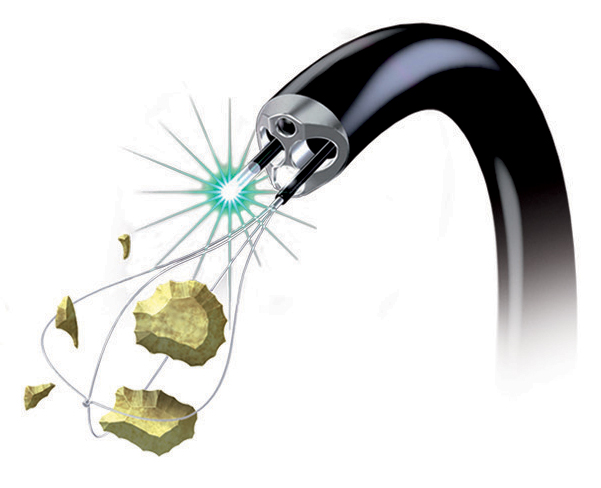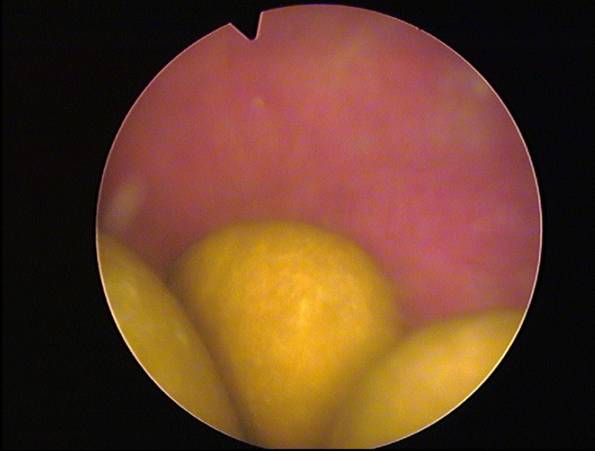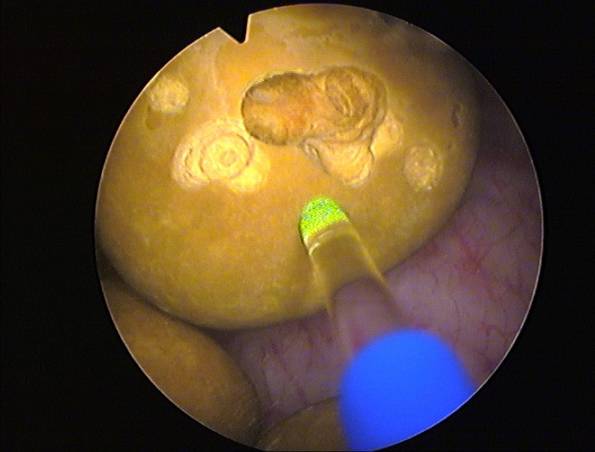Laser therapy for bladder stones using the combined pulse laser
Lithotripsy, the term also used for the fragmentation of a bladder stone using a laser, is a very gentle procedure, which enables patients to regain their quality of life after just a short stay in the clinic. In the Clinic for Prostate Therapy, a double laser procedure is used to treat bladder stones. Firstly, the painful bladder stones are fragmented and secondly, the cause of the bladder stones - namely a benign enlargement of the prostate - is effectively and sustainably eliminated.
What causes bladder stones?
Nerve damage or - in many cases - a benign enlargement of the prostate, prevents the bladder from emptying itself completely. This leads to the flocculation of urine salts and the formation of concretions. These stones are usually painful and often cause infections in the bladder and prostate area. As a rule, open surgery is then carried out promptly on the bladder through the abdominal wall and this involves a lengthy stay in hospital.
The Heidelberg Clinic for Prostate Therapy, which for many years has been the pioneer in Germany for alternative, gentle methods of prostate treatment, is now taking a completely different approach: instead of the classic surgical operation, it is using a newly developed "Holmium YAG laser" (Ho:YAG) from the German manufacturer Wolf, based in Knittlingen in Southern Germany. The fibre of a "MegaPulse 30+" laser is guided via a cystoscope, an instrument for examining the bladder, through the urethra into the bladder and here it fragments the bladder stones with pulsed energy bursts of 200 to 4000 millijoules (mJ).
During the treatment, the urologists go through an impulse spectrum of 3 to 25 Hertz, as each stone has a different structure and each stone is destroyed by a different impulse sequence. Each pulse is extremely short - only 150 to 850 microseconds (µs, a millionth of a second.) Depending on the quantity and size of the bladder stones, laser treatment lasts between just a few minutes and a hour. As patients are given a light anaesthetic, they do not feel the procedure being undertaken.

Photo: Wolf GmbH
The problem of urine retention is eliminated
Using this method of "laser lithotripsy", stone remnants are extracted using suction or pass out with the urine. The enlargement of the prostate that is responsible for the urine retention is treated a few weeks later. The state-of-the-art > Greenlight laser is used here. With a power output of 180 watt, it is also able to treat prostate glands significantly larger than 100 grams. The green laser light gently removes the excess tissue according to the principle of photoselective vaporisation, so that the patient can already resume normal activities the day after treatment and return to work - without having to undergo a lengthy and demanding operation with serious side-effects. The risk of potency restriction is also very low in the case of this laser treatment.

Photo: Heidelberg Clinic for Prostate Therapy

Photo: Heidelberg Clinic for Prostate Therapy
Low medical risk
As the sharp edges of the bladder stones can cause injury to the bladder during laser lithotripsy, and in rare cases infection can occur, antibiotics are always prescribed after treatment. In any case, the medical benefits of a gentle method of treatment greatly outweigh the risk of injury involved in laser lithotripsy. As women also suffer from bladder stones, the laser lithotripsy procedure is in principle also suitable for female patients. Following the removal of bladder stones, women are advised to have a specialist neuro-urological follow-up consultation.
If men suffer from bladder voiding dysfunction that is not caused by an enlargement of the prostate, but is neuronal, that is to say nerve-related, there are other treatment options available. The attempt can be made to prevent the formation of bladder stones through acidification of the urine or the patient can be trained to insert a catheter themselves several times a day, to initiate urine flow.
